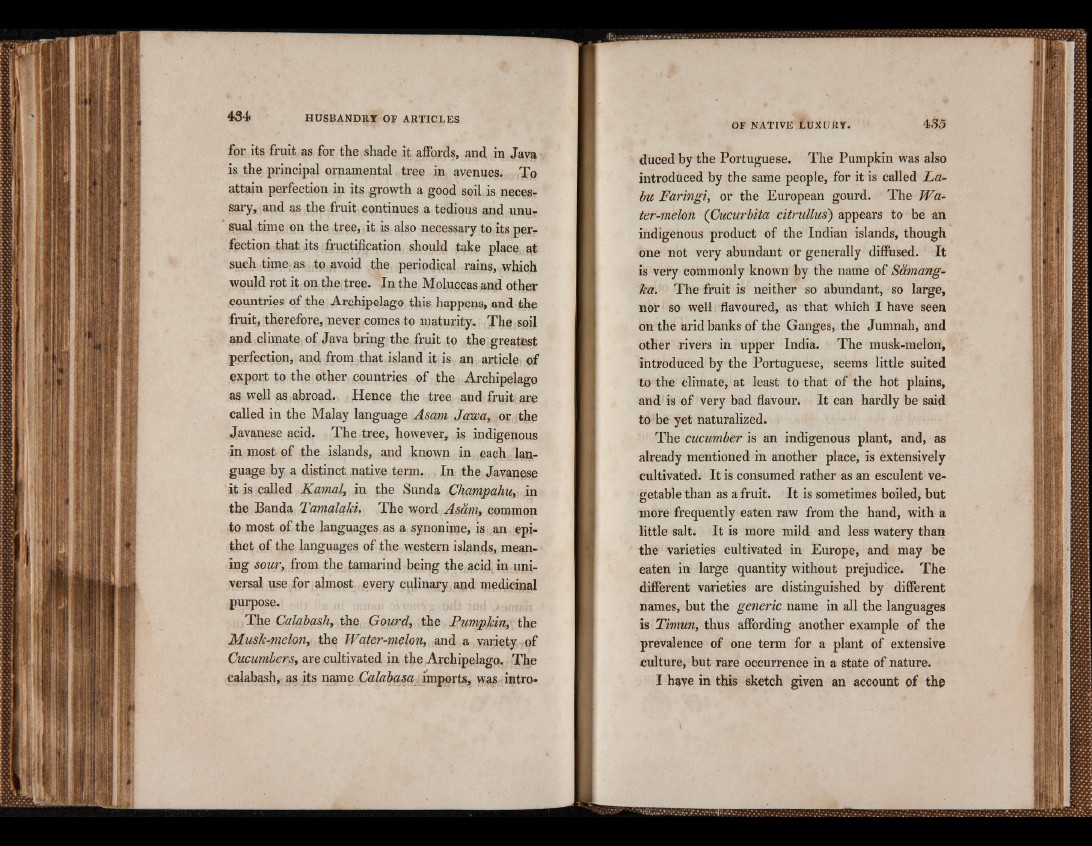
for its fruit as for the shade it affords, and in Java
is the principal ornamental tree in avenues. To
attain perfection in its growth a good soil, is necessary,
and as the fruit continues a tedious and unusual
time on the tree, it is also necessary to its perfection
that its fructification should take place, at
such time as to avoid the periodical rains, which
would rot it on the tree. In the Moluccas and other
countries of the Archipelago this happens, and the
fruit, therefore, never comes to maturity. The soil
and climate of Java bring the fruit to the greatest
perfection, and from that island it is an article of
export to the other countries of the Archipelago
as well as abroad. Hence the tree and fruit are
called in the Malay language Asam Jawa, or the
Javanese acid. The tree, however, is indigenous
in most of the islands, and known in each language
by a distinct native term. In the Javanese
it is called Kamal, in the Sunda Champahu, in
the Banda Tamalaki. The word Asam, common
to most of the languages as a synonime, is an epithet
of the languages of the western islands, meaning
sour, from the tamarind being the acid in universal
use for almost every culinary and medicinal
purpose.
The Calabash, the Gourd, the Pumpkin, the
Musk-melon, the Water-melon, and a variety of
Cucumbers, are cultivated in the Archipelago, The
calabash, as its name Calabasa imports, was introduced
by the Portuguese. The Pumpkin was also
introduced by the same people, for it is called La-
bu Faringi, or the European gourd. The Water
melon (Cucurbita citrullus) appears to be an
indigenous product of the Indian islands, though
one not very abundant or generally diffused. It
is very commonly known by the name of Samang-
ka. The fruit is neither so abundant, so large,
nor so well flavoured, as that which I have seen
on the arid banks of the Ganges, the Jumnah, and
other rivers in upper India. The musk-melon,
introduced by the Portuguese, seems little suited
to the climate, at least to that of the hot plains,
and is of very bad flavour. It can hardly be said
to be yet naturalized.
The cucumber is an indigenous plant, and, as
already mentioned in another place, is extensively
cultivated. It is consumed rather as an esculent vegetable
than as a fruit. It is sometimes boiled, but
more frequently eaten raw from the hand, with a
little salt. It is more mild and less watery than
the varieties cultivated in Europe, and may be
eaten in large quantity without prejudice. The
different varieties are distinguished by different
names, but the generic name in all the languages
is Timun, thus affording another example of the
prevalence of one term for a plant of extensive
culture, but rare occurrence in a state of nature.
I have in this sketch given an account pf the